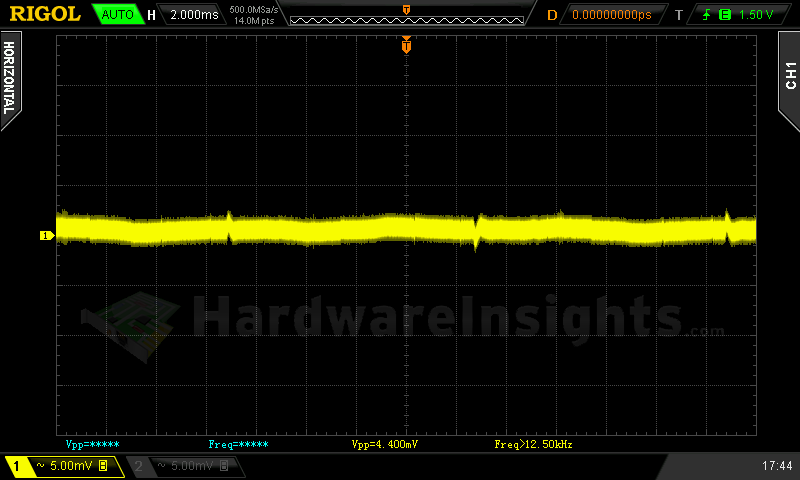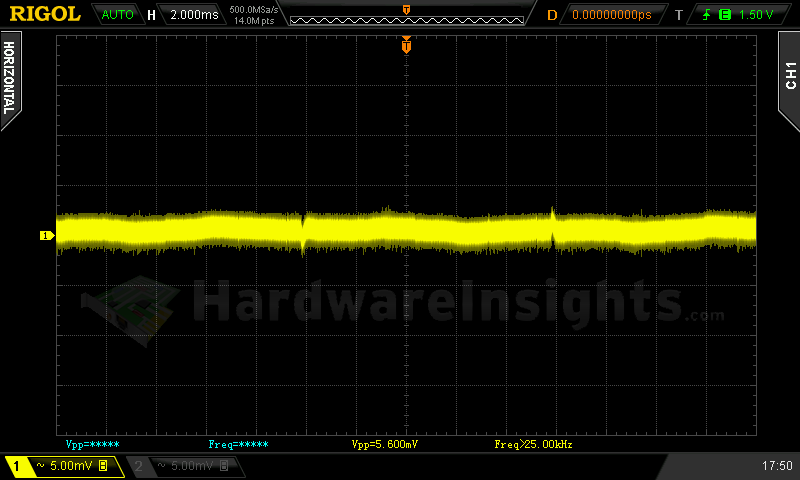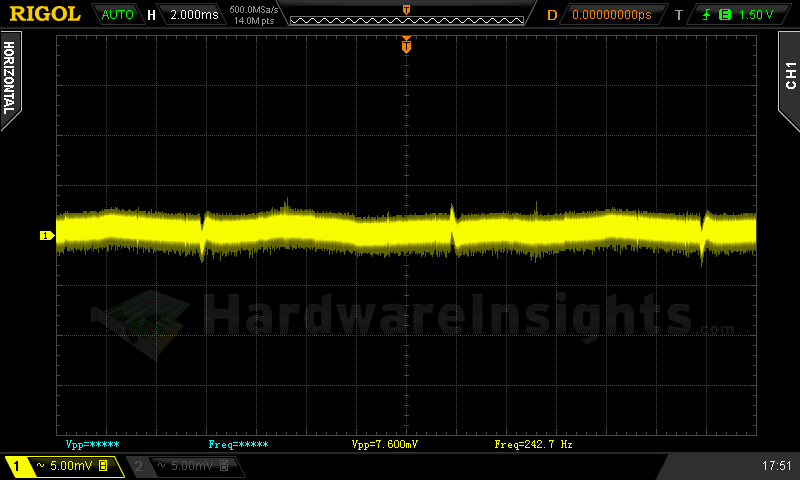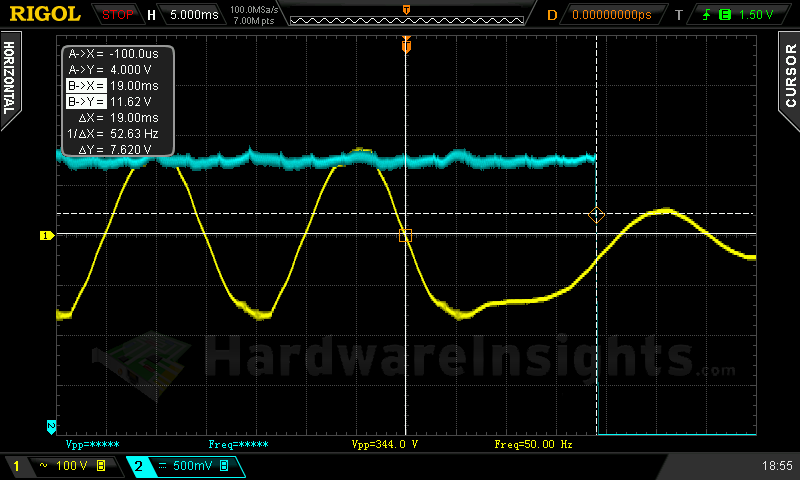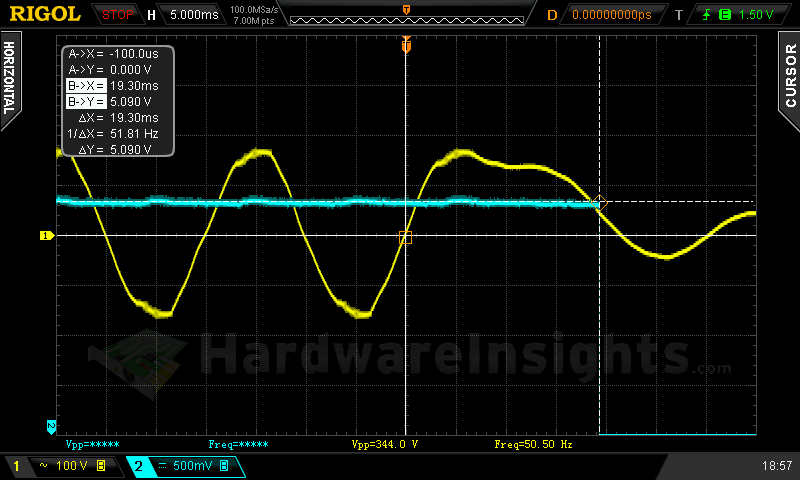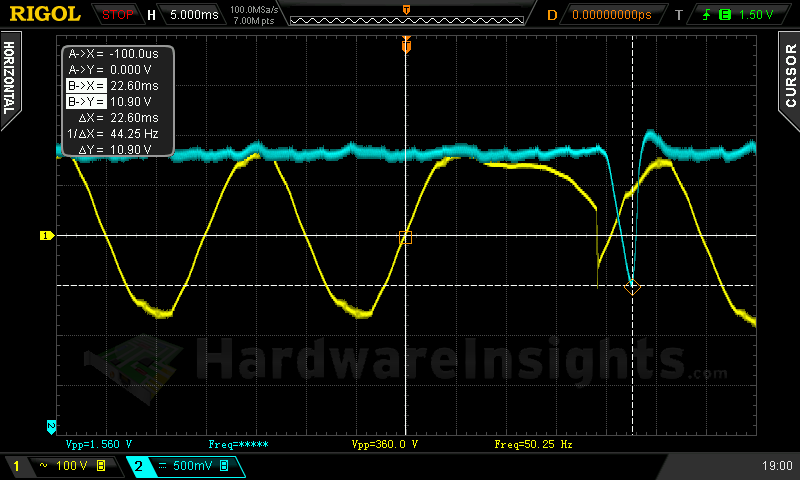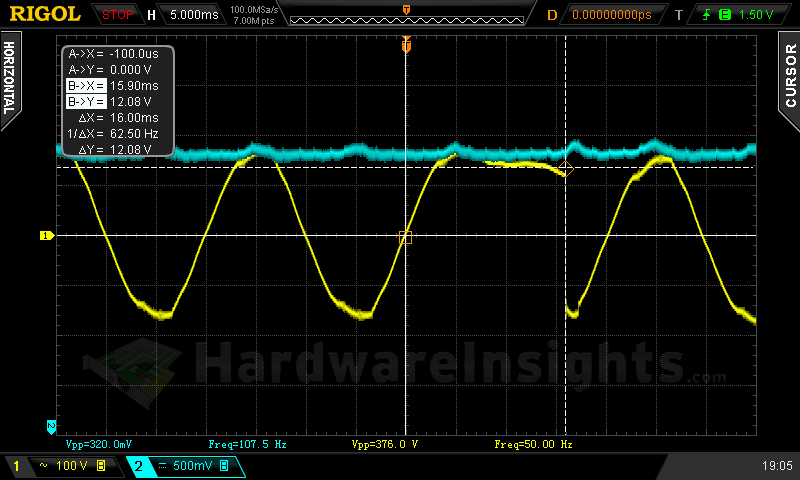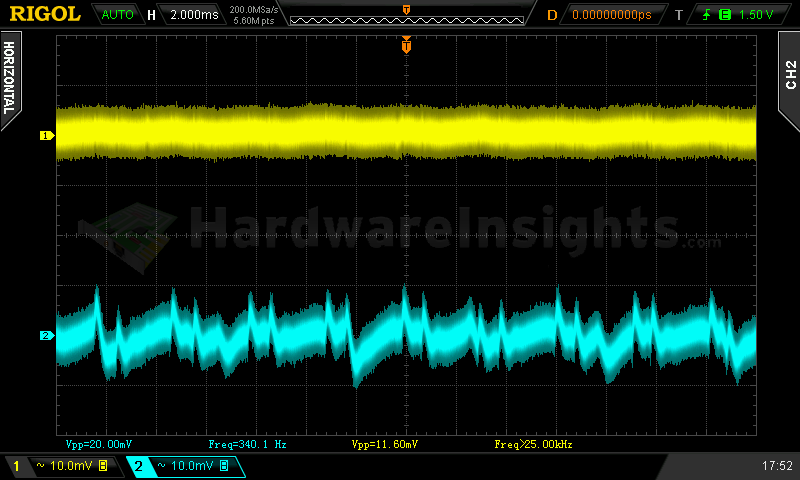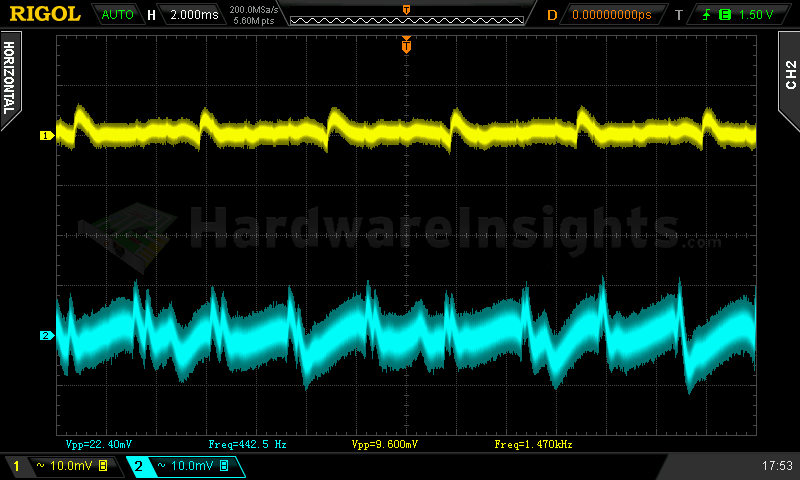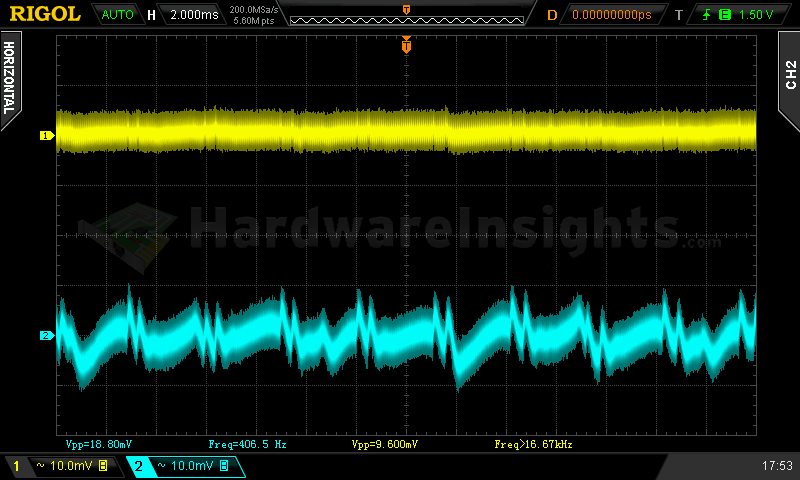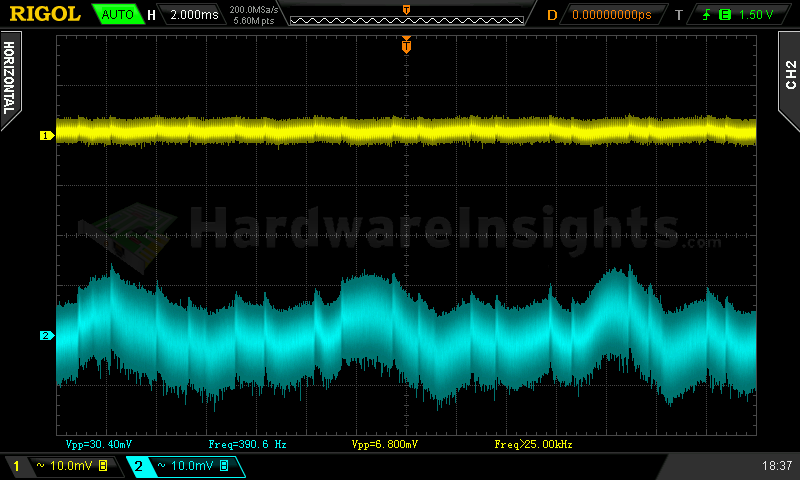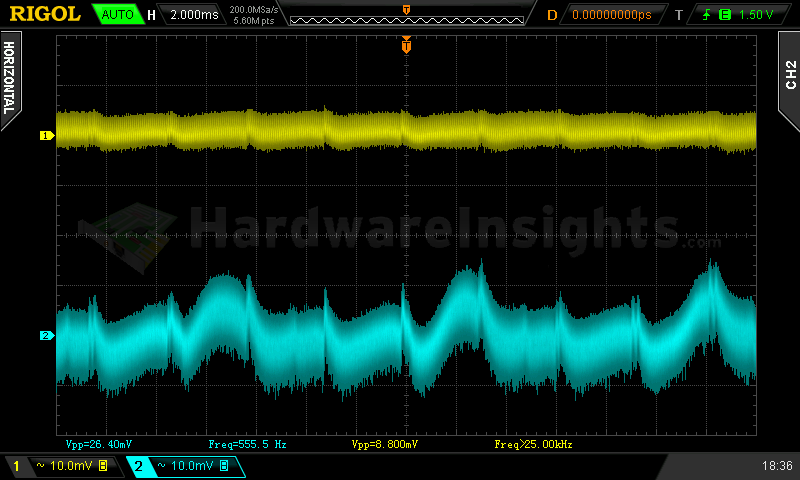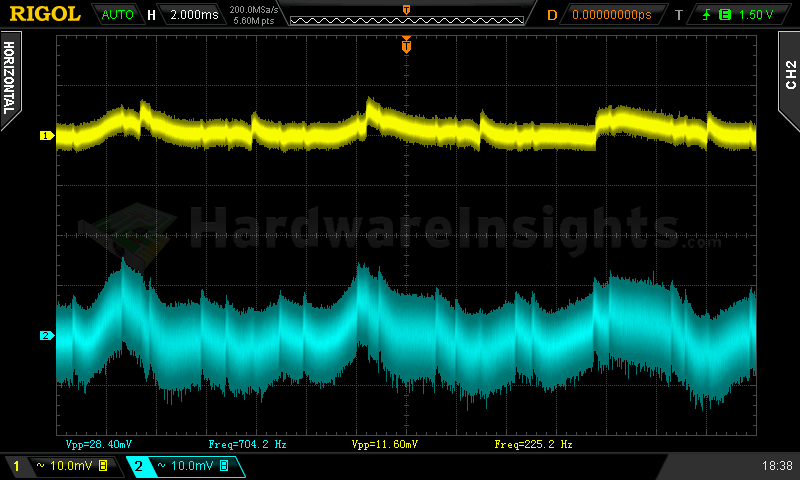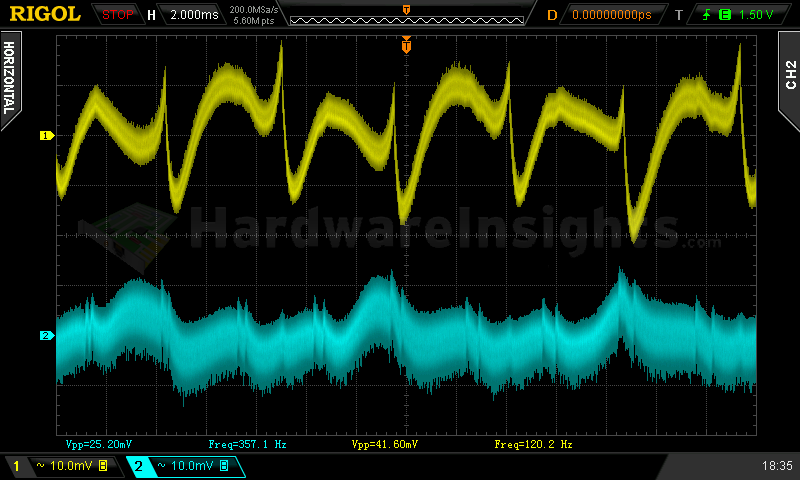Contents
- 1Introducing the Crono PS350N
- 1.1Packaging and accessories
- 2Connectors & cabling
- 2.1Casing & cooling
- 3Input filtering
- 4Primary side
- 4.1+5 V stand-by rail
- 5Secondary side
- 5.1Build quality
- 6Load testing
- 6.1Loading +5 V SB
- 6.2Hold-up time
- 6.3Combined loading
- 6.4Combined loading ripple
- 6.5Crossloading, overloading
- 6.6Crossloading, overloading ripple
- 6.7Fan speed, temperatures and noise
- 7Conclusion and evaluation
- 7.1Thanks
- 7.2Discussion
Load testing
Loading +5 V SB
As always, all load testing is done according to our testing methodology. The voltage regulation and ripple suppression is OK. Efficiency is below average but close to 70 % so that is not so bad. However, it still has no-load consumption of 1.18 W. So like the previous wonders, the Crono PS350N also does not comply with EUC order 1275/2008 and it is illegal to sell it in the whole EU!
| Output (W) | Load (A) | Voltage (V)/ ripple (mV) | Input (W) | Efficiency/power factor |
| 0 | 0 | 5.159/4.400 | 1.18 | —/0.145 |
| 19.36 | 1.93 | 5.025/5.600 | 14.40 | 67.2 %/0.545 |
| 23.26 | 3.31 | 4.864 /7.600 | 23.59 | 68.3 %/0.588 |
+5 V SB ripple (left to right): 0 A; 1.93 A; 3.31 A
Hold-up time
As we can see on the oscilloscope screenshot, the hold-up time of the PS350N +12 V rail appears to be very long at 19 ms. I have been wondering how exactly the strange AC line waveform originated as it was interrupted at 0. Since I see this for the first time, it seems odd, but it is good to realize this unit has no PFC and it is the very first one such to actually be tested here as it delivered the power.
The hold-up time of the power good signal is however longer than the voltage hold-up time. As the PWM driver & monitor combo chip is on secondary and the topology is obsolete and simple, it does not really detect the lack of input power till its power is cut off. It also has some “momentum” so it keeps supplying PG signal for a while, longer than the output voltages are present. But this is wrong.
While interrupting the power for a given time, I found the +12V rail voltage was dropping significantly. So I had to shorten the time, but now it was also shutting down at approx. each whole second (while it was still running at each x.5 s).
The minimum time to stay within proper ATX voltage regulation (and keep running in the first place) is exactly 16 ms. That is exactly the minimum hold-up time according to the norm itself. Coincidence?
Combined loading
As already mentioned and obvious from the hold-up time testing, combined loading was OK for the Crono PS350N. You read right, this is the first obsolete half-bridge platform which delivered 100 % of its rated power. (There was also the SilentiumPC Elementum, but that is much more modern two-transistor forward platform from CWT). Actually, it delivered even slightly more, as the voltage at +12 V increased a bit so did the current. For a while at least, after about 5 minutes the OPP kicked in and shut the unit down. However, at the same time the voltage at −12V rail went through the roof. And that was with over 0.4 A draw from it, while a real system will draw close to nothing from −12 V. So the voltage in such a case will be even higher. The regulation of this rail is overall very poor, it goes from 11.061 to 13.282 V or over 20 %!
| Output power | Load/ voltage +5 V SB | Load/ voltage +3.3 V | Load/ voltage +5 V | Load/ voltage +12 V | Load/ voltage −12 V | Input power | Efficiency/ power factor |
| 8.3 %/ 29.17 W | 0 A/ 5.153 V | 0.009 A/ 3.414 V | 0.398 A/ 5.185 V | 1.902 A/ 12.089 V | 0.369 A/ −11.061 V | 46.81 W | 62.3 %/ 0.621 |
| 20 %/ 68.36 W | 0.540 A/ 5.105 V | 1.491 A/ 3.398 V | 1.584 A/ 5.151 V | 3.98 A/ 12.107 V | 0.373 A/ −11.263 V | 93.86 W | 72.8 %/ 0.640 |
| 40 %/ 145.24 W | 1.013 A/ 5.050 V | 2.79 A/ 3.377 V | 3.41 A/ 5.115 V | 9.06 A/ 12.018 V | 0.379 A/ −11.562 V | 190.0 W | 76.4 %/ 0.644 |
| 60 %/ 199.87 W | 1.002 A/ 5.032 V | 3.94 A/ 3.362 V | 4.85 A/ 5.082 V | 12.74 A/ 11.958 V | 0.389 A/ −11.822 V | 262.5 W | 76.1 %/ 0.647 |
| 80 %/ 261.39 W | 1.45 A/ 4.966 V | 7.32 A/ 3.331 V | 8.81 A/ 4.976 V | 14.91 A/ 12.144 V | 0.398 A/ −12.338 V | 352.4 W | 74.2 %/ 0.646 |
| 100 %/ 361.08 W | 1.75 A/ 4.884 V | 9.64 A/ 3.277 V | 14.03 A/ 4.765 V | 20.24 A/ 12.278 V | 0.422 A/ −13.282 V | 530.6 W | 68.1 %/ 0.662 |
This is true group-regulated unit with +5/+12 V feedback combined. Depending on the +5 V/+12 V loading ratio the voltages also on these rails flow across the whole spectrum. Notice that under maximum possible load the +5 V is almost out of spec. The efficiency was tiny bit better than of similar units we have seen before and peaked over 76 %. However at maximum load the platform was already pushed to the limit as the efficiency dropped hard.
Combined loading ripple
The ripple values of the Crono PS350N are surprisingly very nice. I wonder what part the absence of active PFC plays in such low ripple; it is quite possible the ripple results of many units are bad because of the APFC, especially with small bulk capacitors.
| Output % | Ripple +5 V SB | Ripple +3.3 V | Ripple +5 V | Ripple +12 V | Ripple −12 V |
| 8.3 | 11.60 mV | 9.600 mV | 9.600 mV | 22.40 mV | 29.60 mV |
| 20 | 6.400 mV | 6.000 mV | 11.60 mV | 21.20 mV | 31.20 mV |
| 40 | 10.40 mV | 7.200 mV | 11.60 mV | 21.20 mV | 31.20 mV |
| 60 | 6.40 mV | 7.200 mV | 10.00 mV | 24.00 mV | 30.40 mV |
| 80 | 6.000 mV | 6.000 mV | 10.80 mV | 25.60 mV | 33.60 mV |
| 100 | 6.800 mV | 8.800 mV | 11.60 mV | 30.40 mV | 41.60 mV |
Ripple 8.3% load (left to right): +5 V SB; +3.3 V; +5 V; −12 V. The second channel is connected to +12 V.
Ripple 100% load (left to right): +5 V SB; +3.3 V; +5 V; −12 V. The second channel is connected to +12 V.
Crossloading, overloading
Crossloading tests were the worst, as could be expected from such topology. Crossloading of the +3.3 V rail, and surprisingly also +12 V went fine. But with +5 V the worst of the PS350N came out. With slightly less than 14 A on that rail the voltage on +12 V was almost 13 V. I have consulted with ATX crossload diagrams for 350W units and increased the load from this rail to conform exactly with the diagram, but that did not help much. So the unit also fails here.
| Output power | Load/ voltage +5 V SB | Load/ voltage +3.3 V | Load/ voltage +5 V | Load/ voltage +12 V | Load/ voltage −12 V | Input power | Efficiency/ power factor |
| 21 %/ 71.99 W | 0.533 A/ 5.088 V | 9.93 A/ 3.383 V | 1.565 A/ 5.094 V | 1.912 A/ 12.284 V | 0.373 A/ −11.352 V | 106.1 W | 67.9 %/ 0.637 |
| 36 %/ 125.18 W | 0.526 A/ 5.073 V | 1.438 A/ 3.371 | 13.82 A/ 4.874 V | 3.53 A/ 12.902 V | 0.392 A/ −12.168 V | 170.8 W | 73.3 %/ 0.641 |
| 52 %/ 182.91 W | 0.529 A/ 5.078 V | 1.435 A/ 3.374 V | 1.586 A/ 5.171 V | 13.95 A/ 11.665 V | 0.386 A/ −11.544 V | 240.1 W | 76.2 %/ 0.646 |
The efficiency while crossloading +3.3/+5 V rails was better than of similar units so far. As for the protections, there is obviously nothing but the OPP which I already saw in action under combined loading. So there was nothing really to test here.
Crossloading, overloading ripple
Here the ripple was also OK.
| Output % | Ripple +5 V SB | Ripple +3.3 V | Ripple +5 V | Ripple +12 V | Ripple −12 V |
| 21 | 12.80 mV | 13.60 mV | 14.40 mV | 28.40 mV | 32.00 mV |
| 36 | 5.600 mV | 6.000 mV | 8.800 mV | 22.40 mV | 32.80 mV |
| 52 | 6.000 mV | 8.400 mV | 9.600 mV | 24.40 mV | 32.80 mV |
Fan speed, temperatures and noise
The fan inside the Crono PS350N started spinning right when the unit powered on. And as expected, it ran pretty much at full speed the whole time as thermistor in series with a fan is hardly any speed controller at all. Due to low speed it is not really that noisy, at 38.8 dBA ambient the noise reached about 40 dBA.
| Output % | Fan speed (RPM) | Temperature intake/ outtake | Noise (dBA) |
| 8.3 | 1168 | 21 °C/ 22 °C | 39.5 |
| 20 | 1187 | 21 °C/ 23 °C | 39.6 |
| 40 | 1213 | 22 °C/ 26 °C | 39.6 |
| 60 | 1230 | 23 °C/ 30 °C | 39.7 |
| 80 | 1280 | 24 °C/ 34 °C | 39.9 |
| 100 | 1345 | 24 °C/ 45 °C | 40.1 |
| CL 21 | 1247 | 22 °C/ 27 °C | 39.7 |
| CL 36 | 1285 | 22 °C/ 27 °C | 39.9 |
| CL 52 | 1216 | 22 °C/ 29 °C | 39.6 |
At the maximum power the PS350N delivered it was running quite hot though it was still not close to melting like other cheap wonders. I think that this unit could take use of proper fan controller and fan with maximum speed of about 1500 RPM, then it would be OK. I did not put it in sweater though as the result is pretty much obvious, there is no chance it will survive for 15 minutes under full load. It barely delivered rated power, that’s the best you can expect from it because of such slow fan.
